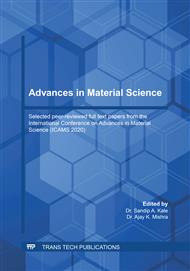[1]
Perrin, Claude, and Cyril Blois. Method of producing decorative paper and decorative laminate comprising such decorative paper., U.S. Patent No. 9,567,713. 14 Feb. (2017).
Google Scholar
[2]
Norlander, Leif, Annika Karlsson, and Mats Fredlund. Paper or paperboard laminate and method to produce such a laminate., U.S. Patent No. 6,537,680. 25 Mar. (2003).
Google Scholar
[3]
Martin Jr, Leslie L. Paper laminate and method for producing the laminate and paperboard containers., U.S. Patent No. 4,806,398. 21 Feb. (1989).
Google Scholar
[4]
Jalil, Md Abdul, Md Nannu Mian, and Muhammad Khalilur Rahman. Using plastic bags and its damaging impact on environment and agriculture: An alternative proposal., International Journal of Learning & Development 3.4 (2013): 1-14.
DOI: 10.5296/ijld.v3i4.4137
Google Scholar
[5]
Adane, Legesse, and Diriba Muleta. Survey on the usage of plastic bags, their disposal and adverse impacts on environment: A case study in Jimma City, Southwestern Ethiopia., Journal of Toxicology and Environmental Health Sciences 3.8 (2011): 234-248.
Google Scholar
[6]
Jakovcevic, Adriana, et al. Charges for plastic bags: Motivational and behavioral effects., Journal of Environmental Psychology 40 (2014): 372-380.
DOI: 10.1016/j.jenvp.2014.09.004
Google Scholar
[7]
Alam, Ohidul, Mukaddis Billah, and Ding Yajie. Characteristics of plastic bags and their potential environmental hazards., Resources, Conservation and Recycling 132 (2018): 121-129.
DOI: 10.1016/j.resconrec.2018.01.037
Google Scholar
[8]
Xanthos, Dirk, and Tony R. Walker. International policies to reduce plastic marine pollution from single-use plastics (plastic bags and microbeads): a review., Marine pollution bulletin 118.1-2 (2017): 17-26.
DOI: 10.1016/j.marpolbul.2017.02.048
Google Scholar
[9]
Clapp, Jennifer, and Linda Swanston. Doing away with plastic shopping bags: international patterns of norm emergence and policy implementation., Environmental politics 18.3 (2009): 315-332.
DOI: 10.1080/09644010902823717
Google Scholar
[10]
Kish, Richard J. Using legislation to reduce one‐time plastic bag usage., Economic Affairs 38.2 (2018): 224-239.
DOI: 10.1111/ecaf.12287
Google Scholar
[11]
Joseph, Nitin, et al. Usage of plastic bags and health hazards: A study to assess awareness level and perception about legislation among a small population of Mangalore city., Journal of clinical and diagnostic research: JCDR 10.4 (2016): LM01.
DOI: 10.7860/jcdr/2016/16245.7529
Google Scholar
[12]
Narancic, Tanja, and Kevin E. O'Connor. Plastic waste as a global challenge: are biodegradable plastics the answer to the plastic waste problem?., Microbiology 165.2 (2019): 129-137.
DOI: 10.1099/mic.0.000749
Google Scholar
[13]
Huang, Jan‐Chan, Aditya S. Shetty, and Ming‐Song Wang. Biodegradable plastics: a review., Advances in Polymer Technology 10.1 (1990): 23-30.
Google Scholar
[14]
Dilkes-Hoffman, L. S., et al. The role of biodegradable plastic in solving plastic solid waste accumulation., Plastics to Energy. William Andrew Publishing, 2019. 469-505.
DOI: 10.1016/b978-0-12-813140-4.00019-4
Google Scholar
[15]
Haider, Tobias P., et al. Plastics of the future? The impact of biodegradable polymers on the environment and on society., Angewandte Chemie International Edition 58.1 (2019): 50-62.
Google Scholar
[16]
Verma, B. B. Continuous jute fibre reinforced laminated paper composite and reinforcement-fibre free paper laminate., Bulletin of Materials Science 32.6 (2009): 589-595.
DOI: 10.1007/s12034-009-0090-0
Google Scholar
[17]
Kumar, Pawan, A. Chaturvedi, and B. B. Verma. Jute and cotton fiber reinforce paper laminates and their characterization., (2011).
Google Scholar
[18]
Technical Association of the Pulp, and Paper Industry. TAPPI test methods. Tappi, (1992).
Google Scholar
[19]
Swenson, Daniel, and Mark James. FRANC2D/L: A crack propagation simulator for plane layered structures." Short User,s Guide, Version 1 (1997).
Google Scholar
[20]
Wawrzynek, Paul, and Anthony Ingraffea. FRANC2D: A two-dimensional crack propagation simulator. Version 2.7: User's guide., (1994).
Google Scholar
[21]
Swenson, Daniel, et al. CASCA: a simple 2-D mesh generator., (1997).
Google Scholar
[22]
Kumar, Pawan, et al. Prediction of the Propagation of Fatigue Cracks in Part-Through Cracked Pipes with CASCA and FRANC2D., Transactions of the Indian Institute of Metals (2020): 1-4.
DOI: 10.1007/s12666-020-01886-z
Google Scholar


